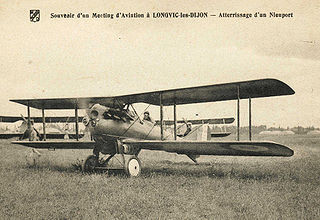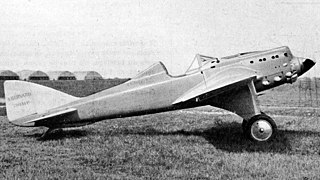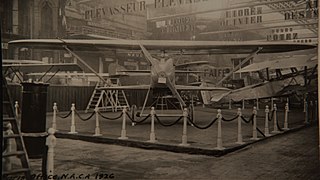Related Research Articles

The Fiat CR.1 was an Italian biplane fighter aircraft of the 1920s. Of wood-and-fabric construction, it was designed by Celestino Rosatelli, from whom it gained the 'CR' designation. Its most distinctive feature was that the lower wings were longer than the upper ones.
The Blériot-SPAD S.81 was a French fighter aircraft developed in 1923 to a requirement by the French Air Force. It was flown competitively against the Dewoitine D.1 and was selected over that aircraft due to the Dewoitine's more radical design, leading to an order for 80 aircraft. The S.81 was a single-bay biplane of conventional configuration with I-shaped interplane struts and lacking Herbemont's usual swept upper wing. It featured a wooden fuselage of monocoque construction and metal wings skinned in fabric. Production versions differed from the prototypes in having a lengthened fuselage and larger tail fin.

The Nieuport-Delage NiD.29 was a French single-seat biplane fighter designed and built by Nieuport-Delage for the French Air Force.
The Beardmore W.B.IV was a British single-engine biplane ship-based fighter of World War I developed by Beardmore. Only one was built.
The Beardmore W.B.II was a British biplane fighter prototype of the 1910s.

The Levasseur PL.5 was a carrier-based fighter produced in France in the late 1920s, in response to the 1924 AMBC.2 specification issued by the Service Technique de l'Aéronautique (STAé). It was a conventional, single-bay sesquiplane that carried a crew of two in tandem, open cockpits. Like other Levasseur naval designs of the day, it incorporated several safety features in case of ditching at sea. Apart from small floats attached directly to the undersides of the lower wing, the main units of the fixed, tail-skid undercarriage could be jettisoned in flight, and the underside of the fuselage was given a boat-like shape and made watertight.
The Sopwith 2FR.2 Bulldog was a prototype British two-seat fighter of the First World War. A single-engined biplane, the Bulldog was a fighter/reconnaissance aircraft intended to replace the Bristol F.2 Fighter, but was unsuccessful, with no replacement for the Bristol Fighter being purchased.

The Bernard 20 was a 1920s French single-seat monoplane fighter aircraft designed and built by the Société des Avions Bernard. Originally displayed as a mock-up at the 1928 Paris Air Show it was a low-wing monoplane based on the Bernard V2 racer. The prototype powered by a 400 hp (298 kW) Hispano-Suiza 12Jb inline piston engine first flew in July 1929 from Orly. With its racing inheritance, in 1930 the aircraft flew at a speed of 280 km/h (174 mph). With the lack of interest by the French authorities for monoplanes the project was abandoned after 18 months of test flying.

The CAMS 31 was a 1920s French single-seat fighter biplane flying-boat designed and built by Chantiers Aéro-Maritimes de la Seine (CAMS).

The Macchi M.26 was an Italian flying boat fighter prototype of 1924 designed and manufactured by Macchi.

The Tebaldi-Zari was an Italian fighter prototype of 1919. The Breda company later acquired the rights to it.

The Latécoère 490 was a two-seat, single-engined parasol winged aircraft, designed to a French photographic reconnaissance specification of 1928. Only two prototypes were built.
The Béchereau SAB C.1 was a French single-seat fighter biplane designed by a team led by Louis Béchereau who had designed biplane fighters for SPAD including the SPAD S.VII.

The Bernard 15 C1 or Bernard SIMB AB 15 was a 1920s French single-seat sesquiplane fighter aircraft designed and built by the Société Industrielle des Métaux et du Bois (SIMB). With the structural failure of the earlier Bernard 14 the Bernard 15 was an improved variant with a greater span upper wing. It was powered by a Hispano-Suiza 12Hb inline piston engine and had a fixed tailskid landing gear. The performance was not an improvement on the Bernard SIMB AB 14 and only the prototype was built.

The Vickers F.B.16 was a British single-seat fighter aircraft of the First World War. It was originally designed to be powered by an experimental radial engine, development of which was abandoned. When re-engined with more powerful and reliable water-cooled V-8 engines, the F.B.16 demonstrated good performance, but only a few prototypes were built, the type not entering service.
The Vickers F.B.24 was a British two-seat fighter aircraft of the First World War. Only a few prototypes were built, as, although it had good performance, the Bristol F.2 Fighter was preferred.

The Wibault 12 Sirocco or Wib 12 Sirocco was a two-seat, parasol wing fighter aircraft designed and built in France in the 1920s. Three fighter prototypes were completed, one for the RAF and two Army co-operation variants. There was no series production.

The Buscaylet-de Monge 5/2 was a 1920s French single-seat, parasol-wing fighter prototype designed by Louis de Monge for the Buscaylet et Cie company.
The Blériot 73 was a large First World War French heavy night bomber designed and built by Blériot to the BN3 specification. Only a single prototype was built, which crashed on landing from its first flight, killing the pilot. The Blériot 74, Blériot 75 and Blériot 76, respectively, a heavy bomber / airliner, airliner and heavy bomber, directly evolved mfrom the Blériot 71 / Blériot 73 bombers.

The Borel-Boccaccio Type 3000, also known as Borel C2, was a two-seat fighter designed and built in France to a 1918 C2 specification.